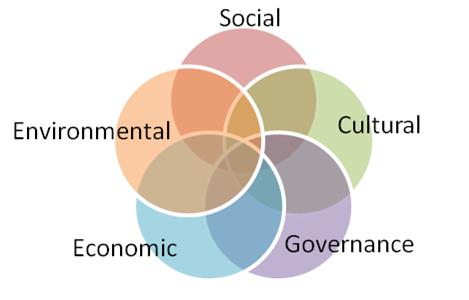| Aerated Compost Systems |
Continuing EducationThe Five Pillars of Sustainability Also Included in this newsletter:

The Five Pillars of SustainabilityThe word "sustainability" has become common in our day-to-day conversation but the meaning and depth of the word is often overlooked. A cursory internet search reveals that the word "sustainability" is used to describe something that can be maintained over time, or that meets the needs of the present without compromising the needs of future generations. A slightly deeper internet search reveals that there are five pillars of sustainability: economic, social, environmental, cultural, and security. Read the full article on our blog to gain a better understanding of these pillars, and find out which one we believe is the most important. You may be surprised. 
UK Project
Tumblebug is an organization in the United Kingdom that understands the Five Pillars of Sustainability. It is working with Blenheim Palace in Woodstock, England to develop a full-scale working model that saves the Palace a considerable amount of money, utilizes the recycled and repurposed organic wastes, and serves as an educational facility for the other Treasured Houses of Britain. Tumblebug's Country Estate Carbon Demonstration Project, the first of its kind in the UK, pioneers practices which unlock the value of the sites' organic waste (food, coffee, compostable packaging, card, manure, green horticultural waste, forestry waste, sheep wool) using Ecobot machines and their patented processes. O2Compost has been invited to participate in this project, providing the design for an aerated compost system to help convert many of the waste streams mentioned above. In 2025, O2Compost will provide operator training for Blenheim Palace staff and others throughout the United Kingdom. We have a lot to unwrap about this organization and the work being done at Blenheim Palace. Stay tuned! Top-Down Benchmark System
If topography supports it, we always recommend a top-down system to provide easy access loading from above. This can be achieved by constructing the bins next to a hillside which allows the land to provide a natural ramp. If the location of your compost system is completely flat, consider building a wood/metal ramp structure on the backside to provide the same benefit. Read more about this new Benchmark System in Fall City, Washington. O2Compost Q&A"I have this big pile of hay that is not horse quality. Can I put it in the compost bin or should I use it as a plenum cover at the bottom of the pile?" ANSWER: Yes, you can certainly compost the residual hay but because it is comprised mostly of cellulose, it will take time to break down. Instead of using it as part of the plenum or cover layers, your best bet would be to mix it in with the manure (the best that you can) and make sure the mix is sufficiently wet. When you remove the compost from the bin there will still be evidence of the hay. It will be a bit stringy and black but it will break down over time as the compost continues to cure. |
|
O2Compost Price-Moon Enterprises, Inc. PO Box 1026 Snohomish, WA 98291 

info@o2compost.com o2compost.com 360.568.8085 |

